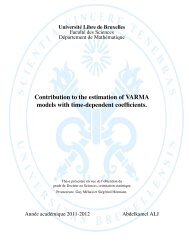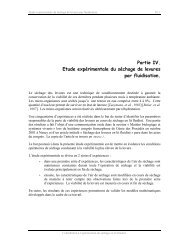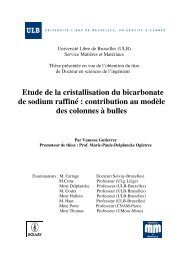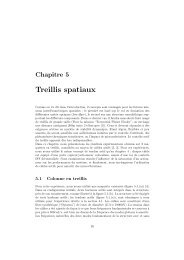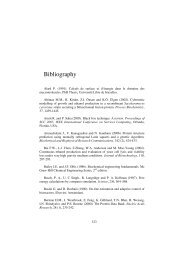Flore <strong>et</strong> <strong>végétation</strong> <strong>de</strong>s <strong>Niayes</strong> <strong>et</strong> <strong>du</strong> Bassin arachidier Tableau 2.3. Représentation <strong>de</strong>s familles botaniques rencontrées dans les <strong>Niayes</strong> (site <strong>de</strong> référence Nof<strong>la</strong>ye <strong>et</strong> vil<strong>la</strong>ges <strong>de</strong> Tou<strong>la</strong>, Darou Alpha <strong>et</strong> Diambalo). Genres Espèces Familles Nof<strong>la</strong>ye % Tou<strong>la</strong> % Darou % Diam- % Nof<strong>la</strong>ye % Tou<strong>la</strong> % Darou % Diam- % Alpha balo Alpha balo N Poaceae 15 11,2 19 14,5 12 12,8 12 11,7 20 10,9 29 15,3 21 14,4 17 11,3 Fabaceae-Faboi<strong>de</strong>ae 11 8,2 8 6,1 8 8,5 8 7,8 25 13,6 16 8,5 22 15,1 25 16,7 Euphorbiaceae 8 6,0 7 5,3 4 4,3 3 2,9 9 4,9 11 5,8 5 3,4 3 2,0 Asteraceae 7 5,2 3 2,3 2 2,1 3 2,9 8 4,3 6 3,2 2 1,4 3 2,0 Capparaceae 6 4,5 2 1,5 1 1,1 2 1,9 7 3,8 2 1,1 1 0,7 3 2,0 Cucurbitaceae 6 4,5 5 3,8 2 2,1 2 1,9 7 3,8 6 3,2 2 1,4 2 1,3 Cyperaceae 5 3,7 5 3,8 4 4,3 3 2,9 5 2,7 6 3,2 6 4,1 5 3,3 Amaranthaceae 5 3,7 5 3,8 4 4,3 4 3,9 7 3,8 7 3,7 5 3,4 4 2,7 Acanthaceae 4 3,0 3 2,3 5 5,3 3 2,9 5 2,7 3 1,6 5 3,4 4 2,7 Rubiaceae 4 3,0 5 3,8 4 4,3 4 3,9 5 2,7 8 4,2 6 4,1 7 4,7 Fabaceae-Mimosoi<strong>de</strong>ae 4 3,0 6 4,6 2 2,1 4 3,9 6 3,3 8 4,2 2 1,4 4 2,7 Tiliaceae 4 3,0 3 2,3 2 2,1 3 2,9 6 3,3 4 2,1 3 2,1 3 2,0 Malvaceae 4 3,0 3 2,3 3 3,2 4 3,9 7 3,8 8 4,2 8 5,5 6 4,0 Fabaceae-Caesalpinioi<strong>de</strong>ae 3 2,2 3 2,3 5 5,3 5 4,9 5 2,7 6 3,2 8 5,5 7 4,7 Convolvu<strong>la</strong>ceae 3 2,2 4 3,1 4 4,3 3 2,9 8 4,3 13 6,9 10 6,8 12 8,0 Moraceae 3 2,2 0 0,0 1 1,1 1 1,0 9 4,9 0 0,0 1 0,7 2 1,3 Anacardiaceae 2 1,5 3 2,3 1 1,1 3 2,9 2 1,1 3 1,6 1 0,7 3 2,0 Apocynaceae 2 1,5 2 1,5 1 1,1 2 1,9 2 1,1 2 1,1 1 0,7 2 1,3 Arecaceae 2 1,5 1 0,8 2 2,1 1 1,0 2 1,1 1 0,5 1 0,7 1 0,7 Asclepiadaceae 2 1,5 2 1,5 0 0,0 2 1,9 2 1,1 2 1,1 2 1,4 2 1,3 Ce<strong>la</strong>straceae 2 1,5 2 1,5 1 1,1 1 1,0 2 1,1 2 1,1 1 0,7 1 0,7 Meliaceae 2 1,5 1 0,8 1 1,1 2 1,9 2 1,1 1 0,5 1 0,7 2 1,3 So<strong>la</strong>naceae 2 1,5 1 0,8 1 1,1 1 1,0 2 1,1 1 0,5 1 0,7 1 0,7 Agavaceae 1 0,7 1 0,8 0 0,0 0 0,0 1 0,5 1 0,5 0 0,0 0 0,0 Aizoaceae 1 0,7 0 0,0 0 0,0 0 0,0 1 0,5 0 0,0 0 0,0 0 0,0 Amaryllidaceae 1 0,7 0 0,0 0 0,0 0 0,0 1 0,5 0 0,0 0 0,0 0 0,0 Ba<strong>la</strong>nitaceae 1 0,7 0 0,0 0 0,0 1 1,0 1 0,5 0 0,0 0 0,0 1 0,7 Bignoniaceae 1 0,7 1 0,8 0 0,0 1 1,0 1 0,5 1 0,5 0 0,0 1 0,7 Bombacaceae 1 0,7 1 0,8 1 1,1 1 1,0 1 0,5 1 0,5 1 0,7 1 0,7 Borraginaceae 1 0,7 1 0,8 1 1,1 1 1,0 1 0,5 1 0,5 1 0,7 1 0,7 Burseraceae 1 0,7 1 0,8 0 0,0 1 1,0 1 0,5 1 0,5 0 0,0 1 0,7 Caryophyl<strong>la</strong>ceae 1 0,7 1 0,8 1 1,1 1 1,0 1 0,5 1 0,5 1 0,7 1 0,7 Chrysoba<strong>la</strong>naceae 1 0,7 2 1,5 1 1,1 1 1,0 1 0,5 3 1,6 1 0,7 1 0,7 Ebenaceae 1 0,7 0 0,0 0 0,0 0 0,0 1 0,5 0 0,0 0 0,0 0 0,0 Gisekiaceae 1 0,7 1 0,8 1 1,1 1 1,0 1 0,5 1 0,5 1 0,7 1 0,7 Lamiaceae 1 0,7 3 2,3 1 1,1 0 0,0 1 0,5 3 1,6 1 0,7 0 0,0 Lauraceae 1 0,7 1 0,8 0 0,0 0 0,0 1 0,5 1 0,5 0 0,0 0 0,0 Loranthaceae 1 0,7 1 0,8 0 0,0 0 0,0 1 0,5 1 0,5 0 0,0 0 0,0 Moringaceae 1 0,7 0 0,0 0 0,0 0 0,0 1 0,5 0 0,0 0 0,0 0 0,0 Nyctaginaceae 1 0,7 1 0,8 1 1,1 1 1,0 1 0,5 3 1,6 2 1,4 1 0,7 Pedaliaceae 1 0,7 1 0,8 3 3,2 1 1,0 1 0,5 1 0,5 4 2,7 1 0,7 Plumbaginaceae 1 0,7 0 0,0 1 1,1 0 0,0 1 0,5 0 0,0 1 0,7 0 0,0 Rhamnaceae 1 0,7 0 0,0 1 1,1 1 1,0 1 0,5 0 0,0 1 0,7 2 1,3 Rutaceae 1 0,7 1 0,8 1 1,1 1 1,0 1 0,5 2 1,1 1 0,7 1 0,7 Sapindaceae 1 0,7 1 0,8 0 0,0 1 1,0 1 0,5 1 0,5 0 0,0 1 0,7 Scrophu<strong>la</strong>riaceae 1 0,7 1 0,8 1 1,1 1 1,0 1 0,5 1 0,5 1 0,7 1 0,7 Sterculiaceae 1 0,7 2 1,5 1 1,1 1 1,0 1 0,5 2 1,1 1 0,7 1 0,7 Verbenaceae 1 0,7 1 0,8 0 0,0 0 0,0 1 0,5 1 0,5 0 0,0 0 0,0 Combr<strong>et</strong>aceae 1 0,7 2 1,5 2 2,1 2 1,9 2 1,1 2 1,1 3 2,1 2 1,3 Commelinaceae 1 0,7 1 0,8 1 1,1 1 1,0 2 1,1 2 1,1 2 1,4 2 1,3 Portu<strong>la</strong>caceae 1 0,7 1 0,8 0 0,0 1 1,0 2 1,1 1 0,5 0 0,0 1 0,7 Annonaceae 0 0,0 1 0,8 1 1,1 1 1,0 0 0,0 1 0,5 2 1,4 1 0,7 Araceae 0 0,0 1 0,8 1 1,1 1 1,0 0 0,0 1 0,5 1 0,7 2 1,3 Asparagaceae 0 0,0 1 0,8 0 0,0 1 1,0 0 0,0 2 1,1 0 0,0 2 1,3 Cactaceae 0 0,0 1 0,8 0 0,0 0 0,0 0 0,0 1 0,5 0 0,0 0 0,0 Caricaceae 0 0,0 1 0,8 0 0,0 0 0,0 0 0,0 1 0,5 0 0,0 0 0,0 Chenopodiaceae 0 0,0 1 0,8 0 0,0 0 0,0 0 0,0 1 0,5 0 0,0 0 0,0 Colchicaceae 0 0,0 1 0,8 0 0,0 0 0,0 0 0,0 1 0,5 0 0,0 0 0,0 Menispermaceae 0 0,0 1 0,8 1 1,1 1 1,0 0 0,0 1 0,5 1 0,7 1 0,7 Molluginaceae 0 0,0 1 0,8 1 1,1 2 1,9 0 0,0 1 0,5 2 1,4 2 1,3 Musaceae 0 0,0 1 0,8 1 1,1 0 0,0 0 0,0 1 0,5 1 0,7 0 0,0 Onagraceae 0 0,0 1 0,8 0 0,0 0 0,0 0 0,0 1 0,5 0 0,0 0 0,0 Typhaceae 0 0,0 0 0,0 0 0,0 1 1,0 0 0,0 0 0,0 0 0,0 1 0,7 Ulmaceae 0 0,0 0 0,0 1 1,1 0 0,0 0 0,0 0 0,0 2 1,4 0 0,0 Vitaceae 0 0,0 1 0,8 0 0,0 0 0,0 0 0,0 1 0,5 0 0,0 0 0,0 Zygophyl<strong>la</strong>ceae 0 0,0 0 0,0 0 0,0 1 1,0 0 0,0 0 0,0 0 0,0 1 0,7 Totaux 134 100 131 100 94 100 103 100 184 100 189 100 146 100 150 100 Globalement, le tableau 2.4 montre que dans le Bassin arachidier, le site <strong>de</strong> référence r<strong>et</strong>enu présente plus <strong>de</strong> genres (106) que les terroirs étudiés qui sont tous en <strong>de</strong>ssous <strong>de</strong> 100 genres. Le terroir peul ou Diaoulé se rapproche le plus <strong>du</strong> milieu naturel. En termes d’espèces, ce terroir est plus riche que le site <strong>de</strong> référence (Sambandé). Celui-ci est uniquement plus diversifié que le site wolof très loin <strong>de</strong>rrière. Les 11 <strong>de</strong>rnières familles ne sont pas représentées dans le site <strong>de</strong> référence. Les familles les plus importantes, en <strong>de</strong>hors <strong>de</strong>s Poaceae <strong>et</strong> <strong>de</strong>s Fabaceae-Faboi<strong>de</strong>ae ont plus <strong>de</strong> représentants génériques comme spécifiques dans le site <strong>de</strong> référence. C’est le cas <strong>de</strong>s 55
Flore <strong>et</strong> <strong>végétation</strong> <strong>de</strong>s <strong>Niayes</strong> <strong>et</strong> <strong>du</strong> Bassin arachidier Euphorbiaceae, <strong>de</strong>s Asteraceae, <strong>de</strong>s Combr<strong>et</strong>aceae, <strong>de</strong>s Acanthaceae, <strong>de</strong>s Lamiaceae, <strong>de</strong>s Tiliaceae. D’autres familles sont représentées dans le site <strong>de</strong> référence mais pas dans les terroirs. On peut en citer : Amaryllidaceae, Borraginaceae, Ce<strong>la</strong>straceae, O<strong>la</strong>caceae, Onagraceae, Opiliaceae, Polyga<strong>la</strong>ceae <strong>et</strong> Sphenocleaceae. Le terroir peul est toujours plus riche en Poaceae que le site <strong>de</strong> référence aussi bien au niveau générique que spécifique. Tableau 2.4. Représentation <strong>de</strong>s familles botaniques rencontrées dans le Bassin arachidier (site <strong>de</strong> référence Sambandé <strong>et</strong> vil<strong>la</strong>ges <strong>de</strong> Diaoulé, Keur Mary <strong>et</strong> Keur Alpha). Genres Espèces Familles Sambandé % Diaoulé % Keur % Keur % Sambandé % Diaoulé % Keur % Keur % Mary Alpha Mary Alpha Poaceae 12 11,3 14 14,3 14 15,2 12 14,0 16 12,1 25 17,0 25 18,7 23 18,0 Fabaceae-Faboi<strong>de</strong>ae 10 9,4 12 12,2 13 14,1 8 9,3 14 10,6 22 15,0 21 15,7 16 12,5 Rubiaceae 6 5,7 6 6,1 6 6,5 3 3,5 7 5,3 7 4,8 7 5,2 5 3,9 Euphorbiaceae 5 4,7 2 2,0 4 4,3 4 4,7 6 4,5 2 1,4 4 3,0 4 3,1 Asteraceae 5 4,7 3 3,1 2 2,2 2 2,3 5 3,8 3 2,0 2 1,5 2 1,6 Fabaceae-Mimosoi<strong>de</strong>ae 4 3,8 4 4,1 2 2,2 3 3,5 7 5,3 6 4,1 3 2,2 3 2,3 Combr<strong>et</strong>aceae 4 3,8 3 3,1 3 3,3 2 2,3 6 4,5 5 3,4 5 3,7 4 3,1 Acanthaceae 4 3,8 3 3,1 2 2,2 1 1,2 5 3,8 3 2,0 2 1,5 1 0,8 Lamiaceae 4 3,8 1 1,0 1 1,1 1 1,2 4 3,0 1 0,7 1 0,7 1 0,8 Malvaceae 3 2,8 3 3,1 3 3,3 2 2,3 6 4,5 8 5,4 8 6,0 5 3,9 Tiliaceae 3 2,8 2 2,0 2 2,2 2 2,3 6 4,5 2 1,4 2 1,5 3 2,3 Fabaceae-Caesalpinioi<strong>de</strong>ae 3 2,8 4 4,1 3 3,3 3 3,5 4 3,0 6 4,1 4 3,0 6 4,7 Amaranthaceae 3 2,8 4 4,1 2 2,2 3 3,5 3 2,3 6 4,1 3 2,2 4 3,1 Anacardiaceae 3 2,8 1 1,0 1 1,1 3 3,5 3 2,3 1 0,7 1 0,7 3 2,3 Borraginaceae 2 1,9 0 0,0 0 0,0 0 0,0 3 2,3 0 0,0 0 0,0 0 0,0 Convolvu<strong>la</strong>ceae 2 1,9 3 3,1 3 3,3 3 3,5 3 2,3 10 6,8 9 6,7 7 5,5 Asclepiadaceae 2 1,9 2 2,0 2 2,2 2 2,3 2 1,5 2 1,4 2 1,5 2 1,6 Capparaceae 2 1,9 1 1,0 2 2,2 0 0,0 2 1,5 1 0,7 2 1,5 0 0,0 Cyperaceae 2 1,9 5 5,1 5 5,4 5 5,8 2 1,5 6 4,1 7 5,2 9 7,0 So<strong>la</strong>naceae 2 1,9 2 2,0 2 2,2 2 2,3 2 1,5 2 1,4 3 2,2 2 1,6 Sterculiaceae 2 1,9 2 2,0 2 2,2 2 2,3 2 1,5 2 1,4 2 1,5 2 1,6 Rhamnaceae 1 0,9 1 1,0 1 1,1 1 1,2 2 1,5 1 0,7 1 0,7 1 0,8 Amaryllidaceae 1 0,9 0 0,0 0 0,0 0 0,0 1 0,8 0 0,0 0 0,0 0 0,0 Araceae 1 0,9 1 1,0 1 1,1 1 1,2 1 0,8 2 1,4 2 1,5 2 1,6 Asparagaceae 1 0,9 0 0,0 0 0,0 1 1,2 1 0,8 0 0,0 0 0,0 1 0,8 Ba<strong>la</strong>nitaceae 1 0,9 1 1,0 1 1,1 1 1,2 1 0,8 1 0,7 1 0,7 1 0,8 Bignoniaceae 1 0,9 1 1,0 1 1,1 0 0,0 1 0,8 1 0,7 1 0,7 0 0,0 Bombacaceae 1 0,9 1 1,0 1 1,1 1 1,2 1 0,8 1 0,7 1 0,7 1 0,8 Burseraceae 1 0,9 0 0,0 1 1,1 0 0,0 1 0,8 0 0,0 1 0,7 0 0,0 Ce<strong>la</strong>straceae 1 0,9 0 0,0 0 0,0 0 0,0 1 0,8 0 0,0 0 0,0 0 0,0 Commelinaceae 1 0,9 1 1,0 1 1,1 1 1,2 1 0,8 2 1,4 2 1,5 2 1,6 Cucurbitaceae 1 0,9 4 4,1 3 3,3 2 2,3 1 0,8 5 3,4 4 3,0 3 2,3 Ebenaceae 1 0,9 1 1,0 1 1,1 0 0,0 1 0,8 1 0,7 1 0,7 0 0,0 Lythraceae 1 0,9 0 0,0 0 0,0 1 1,2 1 0,8 0 0,0 0 0,0 1 0,8 Meliaceae 1 0,9 0 0,0 1 1,1 1 1,2 1 0,8 0 0,0 1 0,7 1 0,8 Molluginaceae 1 0,9 2 2,0 0 0,0 0 0,0 1 0,8 2 1,4 0 0,0 0 0,0 Moraceae 1 0,9 1 1,0 0 0,0 1 1,2 1 0,8 2 1,4 0 0,0 1 0,8 O<strong>la</strong>caceae 1 0,9 0 0,0 0 0,0 0 0,0 1 0,8 0 0,0 0 0,0 0 0,0 Onagraceae 1 0,9 0 0,0 0 0,0 0 0,0 1 0,8 0 0,0 0 0,0 0 0,0 Opiliaceae 1 0,9 0 0,0 0 0,0 0 0,0 1 0,8 0 0,0 0 0,0 0 0,0 Polyga<strong>la</strong>ceae 1 0,9 0 0,0 0 0,0 0 0,0 1 0,8 0 0,0 0 0,0 0 0,0 Sapindaceae 1 0,9 1 1,0 0 0,0 1 1,2 1 0,8 1 0,7 0 0,0 1 0,8 Sphenocleaceae 1 0,9 0 0,0 0 0,0 0 0,0 1 0,8 0 0,0 0 0,0 0 0,0 Verbenaceae 1 0,9 0 0,0 1 1,1 2 2,3 1 0,8 0 0,0 1 0,7 2 1,6 Annonaceae 0 0,0 0 0,0 0 0,0 1 1,2 0 0,0 0 0,0 0 0,0 1 0,8 Anthericaceae 0 0,0 0 0,0 0 0,0 1 1,2 0 0,0 0 0,0 0 0,0 1 0,8 Arecaceae 0 0,0 1 1,0 1 1,1 0 0,0 0 0,0 1 0,7 1 0,7 0 0,0 Chrysoba<strong>la</strong>naceae 0 0,0 0 0,0 0 0,0 1 1,2 0 0,0 0 0,0 0 0,0 1 0,8 Icacinaceae 0 0,0 1 1,0 1 1,1 1 1,2 0 0,0 1 0,7 1 0,7 1 0,8 Strychnaceae 0 0,0 0 0,0 0 0,0 1 1,2 0 0,0 0 0,0 0 0,0 1 0,8 Menispermaceae 0 0,0 0 0,0 0 0,0 1 1,2 0 0,0 0 0,0 0 0,0 1 0,8 Mrytaceae 0 0,0 1 1,0 0 0,0 0 0,0 0 0,0 1 0,7 0 0,0 0 0,0 Nyctaginaceae 0 0,0 1 1,0 1 1,1 1 1,2 0 0,0 3 2,0 1 0,7 1 0,8 Pedaliaceae 0 0,0 1 1,0 1 1,1 1 1,2 0 0,0 1 0,7 1 0,7 1 0,8 Scrophu<strong>la</strong>riaceae 0 0,0 1 1,0 1 1,1 1 1,2 0 0,0 1 0,7 1 0,7 1 0,8 Totaux 106 100 98 100 92 100 86 100 132 100 147 100 134 100 128 100 La comparaison <strong>de</strong> <strong>la</strong> <strong>flore</strong> recensée dans les différents terroirs <strong>et</strong> les sites <strong>de</strong> références sur <strong>la</strong> base <strong>de</strong> l’indice <strong>de</strong> simi<strong>la</strong>rité <strong>de</strong> SØrensen montre une communauté <strong>de</strong>s <strong>végétation</strong>s <strong>de</strong>s terroirs aussi bien dans les <strong>Niayes</strong> que dans le Bassin arachidier avec <strong>de</strong>s taux <strong>de</strong> plus <strong>de</strong> 60 % <strong>de</strong> simi<strong>la</strong>rité. Comparés aux sites <strong>de</strong> référence, ces terroirs se distinguent n<strong>et</strong>tement <strong>de</strong>s <strong>végétation</strong>s <strong>de</strong> référence surtout dans les <strong>Niayes</strong>. Dans le Bassin arachidier, <strong>la</strong> simi<strong>la</strong>rité est à peine supérieure à 50 %. Dans chaque zone, <strong>la</strong> simi<strong>la</strong>rité entre terroirs est plus marquée que celle avec les sites <strong>de</strong> référence (tableau 2.5). 56
- Page 1:
Faculté des Sciences ECOLE INTERFA
- Page 5 and 6:
Avant-propos Ce travail est le cour
- Page 7 and 8:
avoir traduit notre résumé en esp
- Page 9 and 10:
Abstract Partial diagnosis of flora
- Page 11 and 12:
Tableau 4.1. Tests de comparaison d
- Page 13 and 14:
Liste des photographies Photo 1.1 P
- Page 15 and 16:
Introduction générale - le peuple
- Page 17 and 18: Introduction générale (inventaire
- Page 19 and 20: Introduction générale Niayes et d
- Page 21 and 22: Introduction générale - de favori
- Page 23 and 24: Introduction générale 1.3.2. Clim
- Page 25 and 26: Introduction générale Figure 1.5.
- Page 27 and 28: Introduction générale Figure 1.7.
- Page 29 and 30: Introduction générale dépression
- Page 31 and 32: Introduction générale minéraux,
- Page 33 and 34: Introduction générale I. Centre r
- Page 35 and 36: Introduction générale durable. Ce
- Page 37 and 38: Introduction générale Le choix fi
- Page 39 and 40: Introduction générale 1.4.1.3. Si
- Page 41 and 42: Introduction générale Photo 1.1 P
- Page 43 and 44: Introduction générale 1.4.3.2. Da
- Page 45 and 46: Introduction générale d’euphorb
- Page 47 and 48: Introduction générale nécessaire
- Page 49 and 50: Introduction générale 1.6.1. Hypo
- Page 51 and 52: Introduction générale plupart des
- Page 53 and 54: Introduction générale - le chapit
- Page 55 and 56: Flore et végétation des Niayes et
- Page 57 and 58: Flore et végétation des Niayes et
- Page 59 and 60: Flore et végétation des Niayes et
- Page 61 and 62: Flore et végétation des Niayes et
- Page 63 and 64: Flore et végétation des Niayes et
- Page 65 and 66: Flore et végétation des Niayes et
- Page 67: Flore et végétation des Niayes et
- Page 71 and 72: Flore et végétation des Niayes et
- Page 73 and 74: Flore et végétation des Niayes et
- Page 75 and 76: Flore et végétation des Niayes et
- Page 77 and 78: Flore et végétation des Niayes et
- Page 79 and 80: Flore et végétation des Niayes et
- Page 81 and 82: Flore et végétation des Niayes et
- Page 83 and 84: Flore et végétation des Niayes et
- Page 85 and 86: Flore et végétation des Niayes et
- Page 87 and 88: Flore et végétation des Niayes et
- Page 89 and 90: Flore et végétation des Niayes et
- Page 92 and 93: Usages et conservation de la flore
- Page 94 and 95: Usages et conservation de la flore
- Page 96 and 97: Usages et conservation de la flore
- Page 98 and 99: Usages et conservation de la flore
- Page 100 and 101: Usages et conservation de la flore
- Page 102 and 103: Usages et conservation de la flore
- Page 104 and 105: Usages et conservation de la flore
- Page 106 and 107: Usages et conservation de la flore
- Page 108 and 109: Usages et conservation de la flore
- Page 110 and 111: Usages et conservation de la flore
- Page 112 and 113: Usages et conservation de la flore
- Page 114 and 115: Dynamique de la végétation et de
- Page 116 and 117: Dynamique de la végétation et de
- Page 118 and 119:
Dynamique de la végétation et de
- Page 120 and 121:
Dynamique de la végétation et de
- Page 122 and 123:
Dynamique de la végétation et de
- Page 124 and 125:
Dynamique de la végétation et de
- Page 126 and 127:
Dynamique de la végétation et de
- Page 128 and 129:
Dynamique de la végétation et de
- Page 130 and 131:
Dynamique de la végétation et de
- Page 132 and 133:
Dynamique de la végétation et de
- Page 134 and 135:
Dynamique de la végétation et de
- Page 136 and 137:
Dynamique de la végétation et de
- Page 138 and 139:
Dynamique de la végétation et de
- Page 140 and 141:
Dynamique de la végétation et de
- Page 142 and 143:
Dynamique de la végétation et de
- Page 144 and 145:
Dynamique de la végétation et de
- Page 146 and 147:
Dynamique de la végétation et de
- Page 148 and 149:
Dynamique de la végétation et de
- Page 150 and 151:
Importance de la méthode de coupe
- Page 152 and 153:
Importance de la méthode de coupe
- Page 154 and 155:
Importance de la méthode de coupe
- Page 156 and 157:
Importance de la méthode de coupe
- Page 158 and 159:
Importance de la méthode de coupe
- Page 160 and 161:
Importance de la méthode de coupe
- Page 162 and 163:
Importance de la méthode de coupe
- Page 164 and 165:
Importance de la méthode de coupe
- Page 166 and 167:
Importance de la méthode de coupe
- Page 168 and 169:
Discussion générale, conclusions
- Page 170 and 171:
Discussion générale, conclusions
- Page 172 and 173:
Discussion générale, conclusions
- Page 174 and 175:
Discussion générale, conclusions
- Page 176 and 177:
Discussion générale, conclusions
- Page 178 and 179:
Discussion générale, conclusions
- Page 180 and 181:
Discussion générale, conclusions
- Page 182 and 183:
Discussion générale, conclusions
- Page 184 and 185:
Discussion générale, conclusions
- Page 186 and 187:
Références bibliographiques Réf
- Page 188 and 189:
Références bibliographiques Breda
- Page 190 and 191:
Références bibliographiques Flore
- Page 192 and 193:
Références bibliographiques Le Ho
- Page 194 and 195:
Références bibliographiques Sall
- Page 196 and 197:
Table des matières Table des mati
- Page 198 and 199:
Table des matières 3.4.3. Analyses
- Page 200 and 201:
Table des matières 2.16.1.1.2. Sta
- Page 202 and 203:
Annexes au chapitre 2 Annexes au ch
- Page 204 and 205:
Annexes au chapitre 2 Espèces renc
- Page 206 and 207:
Annexes au chapitre 2 Annexe 2.3. L
- Page 208 and 209:
Annexes au chapitre 2 Espèces cit
- Page 210 and 211:
Annexes au chapitre 2 Annexe 2.6. G
- Page 212 and 213:
Annexes au chapitre 2 Annexe 2.7. G
- Page 214 and 215:
Annexes au chapitre 2 Annexe 2.8. G
- Page 216 and 217:
Annexes au chapitre 2 Annexe 2.9. G
- Page 218 and 219:
Annexes au chapitre 2 Scléro T h A
- Page 220 and 221:
Annexes au chapitre 2 Annexe 2.10.
- Page 222 and 223:
Annexes au chapitre 2 Scléro Th Pa
- Page 224 and 225:
Annexes au chapitre 2 Scléro Th AT
- Page 226 and 227:
Annexes au chapitre 2 Scléro Th A
- Page 228 and 229:
Annexes au chapitre 2 Scléro mp SZ
- Page 230 and 231:
Annexes au chapitre 2 Annexe 2.13.
- Page 232 and 233:
Annexes au chapitre 2 Espèces de l
- Page 234 and 235:
Annexes au chapitre 2 Scléro Th Pa
- Page 236 and 237:
Annexes au chapitre 2 Annexe 2.15.
- Page 238 and 239:
Annexes au chapitre 2 Annexe 2.16.
- Page 240 and 241:
Annexes au chapitre 2 Le groupement
- Page 242 and 243:
Annexes au chapitre 2 Hyparrheniete
- Page 244 and 245:
Annexes au chapitre 2 Figure 2.16.2
- Page 246 and 247:
Annexes au chapitre 2 Tableau 2.16.
- Page 248 and 249:
Annexes au chapitre 2 2.16.2. Descr
- Page 250 and 251:
Annexes au chapitre 2 Tableau 2.16.
- Page 252 and 253:
Annexes au chapitre 2 Figure 2.16.4
- Page 254 and 255:
Annexes au chapitre 2 Tableau 2.16.
- Page 256 and 257:
Annexes au chapitre 3 Annexes au ch
- Page 258 and 259:
Annexes au chapitre 3 Intensité d
- Page 260 and 261:
Annexes au chapitre 3 Boscia angust
- Page 262 and 263:
Annexes au chapitre 3 Khaya senegal
- Page 264 and 265:
Annexes au chapitre 3 Annexe 3.3. C
- Page 266:
Annexes au chapitre 3 Fréquence de





